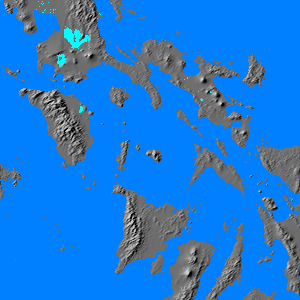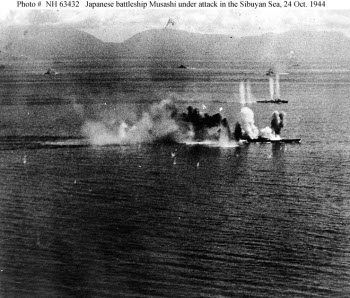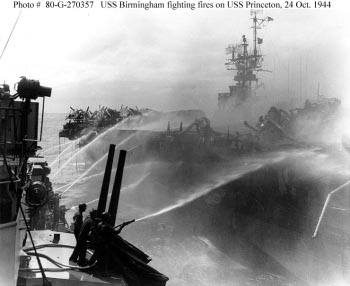![]() The Pacific War Online Encyclopedia
The Pacific War Online Encyclopedia
|
| Previous: Sibert, Franklin C. | Table of Contents | Next: Siege |

The Sibuyan Sea (125.488E
9.781N) is a small sea located south of Luzon, east of Mindoro and north of Panay. It was the location of a major naval engagement on 24 October 1944, part of the Battle of Leyte Gulf.

Naval Historical Center #NH 63432
Battle of the Sibuyan Sea. The Allied liberation of the Philippines began on 20 October 1944 with the invasion of Leyte. Two days later, the Japanese activated their contingency plan for the defense of the Philippines, Sho Ichi Go ("Victory Operation One"). Because the Japanese had virtually no aircraft or pilots left for their carriers, their operational plan relied on their still-powerful surface forces (under Kurita) built around the Yamato and Musashi. These were based at Singapore in order to be close to their fuel supplies, while the carrier forces remained in the Inland Sea. In order to give Kurita a chance to reach and destroy the American amphibious force, Ozawa was ordered to deliberately allow his carriers to be spotted and pursued by Halsey. While Halsey was thus diverted to the north, Kurita was to split his force, taking the main body across the Sibuyan Sea and through San Bernardino Strait north of Leyte Gulf while a detachment under Nishimura would enter Leyte Gulf through Surigao Strait to the south in order to trap the Allied transports between them.
There were several hundred Japanese land-based aircraft scattered throughout the Philippines, but serviceability rates were low and not more than about 200 aircraft participated in the battle. These would be employed primarily in strikes against the American carriers, rather than as air cover for the Japanese naval surface forces, because it was believed that the inexperienced Japanese pilots would have a better chance of protecting Kurita's force by disabling the American flight decks than by attempting to intercept American air strikes. Postwar, staff officers from 2 Air Fleet claimed that they always kept ten fighters above Kurita's force, but Kurita claimed that he never saw any air cover.
Kurita's force was discovered off Palawan on 23 October
1944 by submarines Darter
and Dace, which sank the heavy cruisers Atago
and Maya and severely damaged Takao.
Kurita also detailed two destroyers to escort Takao to safety, which took them out of the battle. The contact
report from the American submarines was the first indication to Allied intelligence that the main
strength of the Japanese Navy was coming out to contest the Leyte
landings. On receiving Darter and Dace's contact report, Halsey immediately alerted the fleet and recalled McCain's
Task Group 38.1, which was on its way to Ulithi for rest and
replenishment. However, McCain's group would not arrive in time for the battle.
Shortly after dawn on 24 October 1944, Kurita brought his force through Mindoro Strait. His ships were sighted on radar by a Helldiver from Intrepid
at 0812, which reported "13DD, 4BB, 8CA". Halsey had the report by 0822
and immediately ordered his three available task groups to concentrate.
At 0837 he ordered his carriers to strike the Japanese force.
Japanese Air Strikes and the Loss of Princeton. The Japanese struck first, however. Three separate raids, of 50 to 60 land-based aircraft, concentrated on Sherman's Task Group 38.3, which was the northernmost of the task groups and thus the nearest to the Japanese bases on Luzon. At 0833 a raid of at least 60 land-based Japanese aircraft was intercepted by seven Hellcats, which ignored the odds and plunged into the Japanese formation. The Japanese bombers scattered while the fighters formed a defensive Lufberry circle. The Essex air group commander, Commander David McCampbell, patiently waited for the Japanese formation to break up, then shot down at least nine Japanese aircraft — a wartime record for a single engagement. McCampbell's wingman accounted for another six aircraft and the rest of the American fighters shot down atleast ten more. McCampbell was subsequently awarded the Medal of Honor.

National Archives #80-G-270357
At 0938, while
the American combat air patrol was
returning from driving off the Japanese strikes, a single Judy dive bomber broke through the
cloud cover and put its 250 kg (550 lb) bomb through
the flight deck of light carrier
Princeton. The bomb penetrated four decks to explode in the ship's bakery, and its blast ignited
gasoline in the hangar deck. Flames began detonating torpedoes loaded onto six Avengers,
dropping one elevator into its well and throwing the other onto the
flight deck. Captain Buracker ordered Salvage Control Phase I at 1010
and Salvage Control Phase II shortly thereafter. The crew fought the fire for almost six
hours but were unable to reach a blaze near the torpedo magazine, and at 1523 a massive
explosion blew up the stern of the ship. There were heavy casualties on
cruiser Birmingham, which had come alongside at 1004 to assist with the firefighting.
Though Princeton was
still afloat, the fires were now burning towards the gasoline storage
and main magazine, and shortly after 1640 Sherman ordered her scuttled.
Destroyer Irwin attempted to deliver the coup de grace,
but her torpedo director had been damaged while she assisted with
firefighting. Only one torpedo connected, and two circular running
torpedo nearly hit Irwin. Light cruiser Reno then fired two torpedoes, one of which hit Princeton's gasoline storage and finally sank the ship.
Meanwhile a second raid in two groups arrived at 1212.
This was Ozawa's entire
striking force, which was intercepted and broken up some 45 miles (70
km) northeast of Sherman's task group. Some 6 to 8 Judys broke through
to the American carriers but scored no hits. Halsey now had a good idea
that the Japanese carriers, whose appearance he had anticipated since
the first contact report from Darter and Dace, were somewhere off to the northwest. However, by then his strikes were already on the way to Kurita's force.
American Air Strikes. Kurita knew he had been
sighted at 0812 and brought his fleet to 25 knots. While Sherman was
fighting off the Japanese air raids, Bogan launched the first of
five American strikes. The strikes are described in the following
table, as best as they can be reconstructed from conflicting sources:
| Launch Time |
Origin |
Composition |
Attack Time |
Damage Inflicted |
| 0910 |
TG 38.2 (Bogan): CV Intrepid CVL Cabot |
21 F6F Hellcats 12 SB2C Helldivers 12 TBF Avengers |
1026 |
BB Musashi: 1 bomb hit, 1 torpedo hit BB Yamato: 1 bomb hit CA Myoko: 1 torpedo hit |
| 1045 |
TG 38.2 (Bogan): | ? F6F Hellcats 8+ SB2C Helldivers 9+ TBF Avengers |
1203 |
BB Musashi: 2 bomb hits, 3 torpedo hits |
| 1050 |
TG 38.3 (Sherman) CV Lexington CV Essex |
16+ F6F Hellcats 17+ SB2C Helldivers 11+ TBF Avengers 5 other aircraft of unknown type |
1330 |
BB Musashi: 4 bomb hits, 4 torpedo hits BB Yamato: 1 bomb hit BB Nagato: 2 bomb hits |
| 1313 |
TG 38.4 (Davison) |
26 F6F Hellcats 21 SB2C Helldivers 18 TBF Avengers 4 other aircraft of unknown type |
1455 |
BB Musashi: 4 bomb hits, 3 torpedo hits |
| 1350 |
TG 38.2 (Bogan): | 16 F6F Hellcats 12 SB2C Hellidivers 3 TBF Avengers |
1515 |
BB Musashi: 7 bomb hits, 8 torpedo hits |
Morison (1958) gives a total of 259 sorties against Kurita on 24 October. The 48 sorties not accounted for in the table presumably were split between the 1045 strike and the Essex component of the 1050 strike, for which Morison does not give exact numbers. However, some sources (e.g. Cox 2012) report only two strikes from Bogan's group, arriving at 1026 and 1245. Japanese sources report six raids, apparently because the 1050 raid attacked in two waves.
The American pilots reported just four Japanese fighters over Kurita's fleet, which were quickly shot down by the Hellcats. Antiaircraft fire was intense and included the first operational use of the San Shiki Model 3 antiaircraft round fired from the 18" guns of Musashi. However, the San Shiki shells proved almost completely ineffective (perhaps because the Musashi's gun director had been damaged) and the American lost just 18 aircraft to antiaircraft fire during the battle.The giant battleship Musashi took the brunt of the attack, sinking after taking 17 bomb hits and 19 torpedo hits. Her commander attempted to beach her, but she capsized at 1935 with the loss of 1,096 of her crew. Battleships Yamato and Nagato each took two bomb hits that inflicted significant damage to their upper works, hindering fire control and communications, and heavy cruiser Myoko took a torpedo hit that damaged two shafts and forced her to withdraw. Other ships were damaged by very near misses. At 1600, Kurita finally reverse course while broadcasting pleas for air cover.
Kurita was not the sole target of American strikes on 24 October. Nishimura was sighted at 0820 by a search group from Enterprise, which immediately attacked and scored one bomb hit each on Fuso and Shigure. However, contact was subsequently lost and Halsey chose to concentrate his strikes on the more dangerous Center Force.
Meanwhile, Ozawa was trying to be detected by the
Americans, unaware that his radio transmitter was malfunctioning and
preventing his radio traffic from being heard by either friend or
foe.
The Americans finally spotted him at 1540, and Halsey,
overestimating the damage to Kurita's force and believing it was
retiring for good, took off in hot
pursuit of
Ozawa with all his forces. Now it was the Americans whose plans were
thrown into confusion. Halsey had transmitted a contingency plan for
detaching his battle line as Task Force 34 to guard San Bernardino
Strait. However, with Kurita seemingly in retreat, Halsey decided this
was unnecessary. But the original message was the only one seen by
other senior commanders (such as Kinkaid
with 7 Fleet in
Leyte Gulf), and they were left with the
mistaken impression that San Bernardino Strait was being watched.
At 1935 a night reconnaissance flight from Independence found that Kurita's force had returned to a course for San Bernardino Strait. It is unclear why Halsey did not then detach Task Force 34 to cover the strait. Mitscher, possibly smarting from having been bypassed all day by Halsey (who issued orders directly to Mitscher's task group commanders), declined to radio such a recommendation to Halsey. Three of Halsey's task force commanders also wondered at the order, and Bogan went so far as to contact Halsey's staff with the information that the navigation lights in San Bernardino Strait were lit. He was brushed off, and made no further protest. Lee, the battle line commander, correctly deduced that Ozawa's force was a decoy with little striking power, but his signal to Halsey warning that Kurita was likely to come out of San Bernardino Strait was also brushed off. Halsey's failure to guard the strait must be judged one of the great blunders of the Pacific War.
| Combined Fleet (Toyoda) |
||||||||
| |
Mobile Force (Ozawa) |
|||||||
| Main Body (Northern Force) (Ozawa) |
||||||||
| Carrier Division 3 (Ozawa) | Combined air strength: 80 A6M Zero, 25 B6N Jill, 4 B5N Kate, 7 D4Y Judy | |||||||
| CV Zuikaku CVL Zuiho CVL Chitose CVL Chiyoda 80 A6M Zero 25 B6N "Jill" 4 B5N "Kate" 7 D4Y "Judy" |
||||||||
| Carrier Division 4 (Matsuda) |
||||||||
| CVBB Hyuga CVBB Ise |
||||||||
| Destroyer Division 61 |
||||||||
| DD Hatsuzuki DD Akitsuki DD Wakatsuki DD Shimotsuki |
On loan from Destroyer Division 41 |
|||||||
| Escort Squadron 31 (Edo) |
||||||||
| CL Isuzu |
||||||||
| Destroyer Division 43 |
||||||||
| DE Maki DE Kiri DE Kuwa DE Sugi |
||||||||
| CL Oyodo CL Tama |
||||||||
| First Striking Force (Kurita) |
||||||||
| Force "A" (Center Force) (Kurita) | ||||||||
| |
First Section (Kurita) | |||||||
| |
|
Battleship Division 1 (Ugaki) |
||||||
| BB Yamato BB Musashi BB Nagato |
Lightly damaged Sunk Lightly damaged |
|||||||
| Cruiser Division 4 (Kurita) | ||||||||
| CA Chokai |
||||||||
| Cruiser Division 5 (Hashimoto) |
||||||||
| CA Myoko CA Haguro |
Severely damaged |
|||||||
| Destroyer Squadron 2 (Hayakawa) |
||||||||
| CL Noshiro DD Shimakaze |
||||||||
| Destroyer Division 2 |
||||||||
| DD Hayashimo DD Akishimo |
||||||||
| Destroyer Division 31 |
||||||||
| DD Kishinami DD Okinami DD Naganami DD Asashimo |
||||||||
| Destroyer Division 32 |
||||||||
| DD Hamanami DD Fujinami |
||||||||
| Second Section (Suzuki) |
||||||||
| Battleship Division 3 (Suzuki) | ||||||||
| BB Kongo BB Haruna |
Slightly damaged by very near misses |
|||||||
| Cruiser Division 7 (Shiraishi) |
||||||||
| CA Kumano CA Suzuya CA Chikuma CA Tone |
Lightly damaged |
|||||||
| Destroyer Squadron 10 (Kimura) |
||||||||
| CL Yahagi DD Nowaki DD Kiyoshimo |
||||||||
| Destroyer Division 17 |
||||||||
| DD Urakaze DD Yukikaze DD Hamakaze DD Isokaze |
||||||||
| Force "C" (Van of Southern Force) (Nishimura) |
||||||||
| Battleship Division 2 (Nishimura) |
||||||||
| BB Yamashiro BB Fuso CA Mogami |
Lightly damaged |
|||||||
| Destroyer Division 4 |
||||||||
| DD Michishio DD Asagumo DD Yamagumo DD Shigure |
Moderately damaged. On loan from Destroyer Squadron 2 |
|||||||
| Fifth Base Air Force and First Air Fleet (Onishi; at Clark) |
Adequate records were never found from which to reconstruct the order of battle for Japanese land-based air forces. Most sources simply speak of several hundred land-based aircraft in the Philippines. During the air battles of 24 October, the American carrier groups were raided by a total of perhaps 200-300 aircraft, but these include Ozawa's carrier aircraft. There were additional kamikaze raids during the Battle of Samar. | |||||||
References
Cox (2012; accessed 2012-11-3)
Cutler (1994)
Hackett and Kingsepp (2012; accessed 2012-11-3)
The Pacific War Online Encyclopedia © 2012 by Kent G. Budge. Index